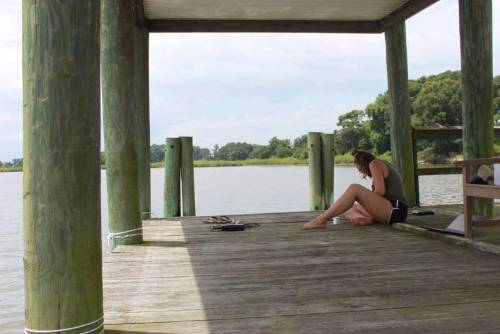The Oyster Whisperers
A summer research project brought together scientists to consider the human impact on native oyster populations in the upper reaches of the Chesapeake Bay.

At the very tip of Land's End Farm, a dock stretches out into the Chester River. From here you can see where the water has gnawed away the center of Nichols Point. In the distance, a log canoe glides by, preparing for the upcoming Governor's Cup races. Osprey whistle and circle away overhead. It is high summer on the Eastern Shore—still, hot, idyllic. This is where Julie St.Clair '22, a young environmental scientist, spends her days—collecting data about water flow at various depths and measuring its effects on spat and young oysters that she and her professor, Jillian Bible, are monitoring as part of a larger oyster study in collaboration with Virginia Institute of Marine Sciences (VIMS).
For St.Clair, a rising sophomore from suburban Philadelphia who chose Washington College on the strength of its environmental science program, it's hard to believe she was lucky enough to land a summer internship, funded by the John S. Toll Fellows summer research program, that required her to conduct testing at four sites along the Chester and Corsica rivers.
St.Clair worked closely on this oyster project with Bible, an assistant professor of environmental science and studies who joined the Washington College faculty last fall. Bible had previously taught at University of California, Davis, where her dissertation in marine ecology focused on local adaptation among Olympia oyster populations and how scientific research can inform conservation and restoration efforts.
“There is no longer a harvest of native oysters on the West Coast. Aquaculture of other species has supplanted natural harvests, but there is a lot of interest in restoring the native species for the ecosystem services that it provides similar to the oysters on this coast, i.e., filtering water and providing habitat for dozens of small organisms at the base of the food chain,” Bible says. “On the West Coast I studied both how oysters are affected by climate change and invasive species, and also whether some populations are more vulnerable to human stresses, and whether some are more robust. Looking at small-scale evolution of populations, we found that some are more, and some less, vulnerable, which helps us prioritize what areas we want to conserve to make sure we have really robust oysters for all the future stresses that are coming.”
For her, it was an easy transition to the Chesapeake region, where oyster populations are also struggling.
“Getting a job at Washington College was ideal for me,” Bible says. “Teaching is my love and passion. Being in a place that has this wonderful environmental program is exactly what I wanted. But also the location is perfect for my research. Although we have a different species of oyster out here and some different human-caused impacts affecting them, my basic research question of how humans impact these really important coastal species like oysters is very easily transferable.”
Here on the East Coast, Bible has teamed up with Emily Rivest, a global change biologist she knew as a post-doctoral student at University of California. Rivest now teaches at VIMS, where she is trying to solve the mystery of how water quality parameters can affect oyster growth. The project is known as the CSI Oyster Project.
“Temperature, salinity, pH, nitrates, chlorophyll—we know a lot about each of these but it's hard to understand how those factors combine to affect an organism,” Bible says.
St.Clair's work this summer added another piece to the puzzle—flow. Using clod cards she made from plaster of paris, St.Clair measured how fast the water moved at various depths, and then measured oyster growth and mortality at those depths. Every week, she and Bible would meticulously measure the spat and young oysters that were hung from mesh bags, and then share their findings with Rivest. Parts of the experiment will continue throughout the year ahead.
“We hypothesized that intermediate flow will be ideal for oyster growth,” St.Clair says. “Too fast, the oysters can't capture nutrients. Too slow, not enough nutrients can reach them.”
Studies such as this take time, as well as the cooperation of waterfront property owners such as Vinton Lawrence, the owner of Land's End Farm. And these studies are particularly important because Washington College is at the northern edge of the oyster's range within the Chesapeake Bay region being investigated by other scientists and non-profit organizations.
“One of the things I'm really interested in is citizen science,” says Bible. “Vint and I connected because of his involvement in the Marylanders Grow Oysters Restoration Program. I love the idea of getting people more involved.”